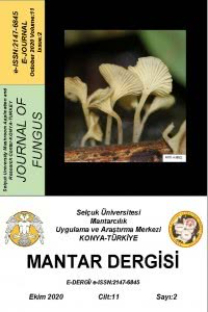Pisolithus albus, Türkiye Gastroid Mantarları İçin Yeni Bir Kayıt
21 Eylül 2020 tarihinde Muğla ili Bodrum ilçesinden mantar örnekleri toplanmış ve hem morfolojik hem de rDNA dizi tabanlı moleküler filogenetik analizler uygulanarak detaylı bir şekilde incelenmiştir. Toplanan örnek (ANK Akata & Altuntaş 699) ile Pisolithus albus (Cooke & Massee) Priest. arasındaki yüksek (>%99) dizi benzerliği ve mikro- ve makromorfolojik veriler göz önüne alındığında, toplanan örnek P. albus olarak tanımlanmıştır. Bu çalışma sonucunda P. albus Türkiye Gastroid mantarları için yeni kayıt olarak rapor edilmiştir. Yeni kaydedilen türün kısa bir tanımı, makro fotoğrafı ve sporların gösterimi ile birlikte sunulmuş ve kısaca tartışılmıştır.
Anahtar Kelimeler:
Pisolithus albus, Gastroid mantarlar, Yeni kayıt, Türkiye
Pisolithus albus, A New Record For Turkish Gastroid Fungi
Fungal specimens were sampled from the Bodrum district of Muğla province / Türkiye on September 21, 2020, and they were scrutinized by performing both morphological and rDNA sequence-based phylogenetic analyses. Considering the micro- and macromorphological data and the high (>99%) sequence similarity between the sampled specimen (ANK Akata & Altuntaş 699) and Pisolithus albus (Cooke & Massee) Priest., the collected specimen was identified as P. albus. As a result of this study, P. albus was reported as a new record for Turkish Gastroid fungi. A brief description of the lately recorded species was stated along with its macro-photograph, and illustration of spores and discussed briefly.
Keywords:
Pisolithus albus, Gastroid fungi, New record, Türkiye,
___
- Chen, L., Cai, Y., Zhou, G., Shi, X., Su, J., Chen, G., and Lin, K. (2014). Rapid Sanger sequencing of the 16S rRNA gene for identification of some common pathogens. PloS one. 9(2), e88886.
- Felsenstein, J. (1985). Confidence limits on phylogenies: an approach using the bootstrap. Evolution. 39(4), 783-791.
- Gargano, M. L., Maisano, S., and Venturella, G. (2018). Pisolithus albus, a new record for Italy. Field mycology. 19(3), 86-89.
- Hosaka, K. (2009). Phylogeography of the genus Pisolithus revisited with some additional taxa from New Caledonia and Japan. Bulletin of the National Museum of Nature and Science. Series B, 35, 151-167.
- Jaouani, A., Gargano, M. L., Ouali, Z., Sbissi, I., Compagno, R., and Venturella, G. (2015). Pisolithus albus (Sclerodermataceae), a new record for Tunisia. Fl. Medit. 25, 73-78.
- Kimura, M. (1980). A simple method for estimating evolutionary rates of base substitutions through comparative studies of nucleotide sequences. Journal of molecular evolution. 16(2), 111-120.
- Kumar, S., Stecher, G., Li, M., Knyaz, C., and Tamura, K. (2018). MEGA X: molecular evolutionary genetics analysis across computing platforms. Molecular biology and evolution. 35(6), 1547.
- Lebel, T., Pennycook, S., and Barrett, M. (2018). Two new species of Pisolithus (Sclerodermataceae) from Australasia, and an assessment of the confused nomenclature of P. tinctorius. Phytotaxa. 348(3), 163-186.
- Martin, F., Díez, J., Dell, B., and Delaruelle, C. (2002). Phylogeography of the ectomycorrhizal Pisolithus species as inferred from nuclear ribosomal DNA ITS sequences. New Phytologist. 153(2), 345-357.
- Mifsud, S. and Mifsud, D. (2022). Investigation on Pisolithus (Fungi, Sclerodermataceae) occurring in the Maltese Islands. Borziana 3: 33-41.
- Moyersoen, B., and Beever, R. E. (2004). Abundance and characteristics of Pisolithus ectomycorrhizas in New Zealand geothermal areas. Mycologia. 96(6), 1225-1232.
- Phosri, C., Martín, M. P., Suwannasai, N., Sihanonth, P., and Watling, R. (2012). Pisolithus: a new species from southeast Asia and a new combination. Mycotaxon. 120 (1), 195-208.
- Raja, H. A., Miller, A. N., Pearce, C. J., and Oberlies, N. H. (2017). Fungal identification using molecular tools: a primer for the natural products research community. Journal of natural products. 80(3), 756-770.
- Rogers, S. O., and Bendich, A. J. (1994). Extraction of total cellular DNA from plants, algae and fungi. In Plant molecular biology manual (pp. 183-190). Springer, Dordrecht.
- Sesli, E. and Denchev, C. M. (2014). Checklists of the myxomycetes, larger ascomycetes, and larger basidiomycetes in Turkey. Mycotaxon 106: 65-67.
- Sesli, E., Asan, A. ve Selçuk, F. (edlr.) Abacı Günyar, Ö., Akata, I., Akgül, H., Aktaş, S., Alkan, S., Allı, H., Aydoğdu, H., Berikten, D., Demirel, K., Demirel, R., Doğan, H.H., Erdoğdu, M., Ergül, C.C., Eroğlu, G., Giray, G., Halikî Uztan, A., Kabaktepe, Ş., Kadaifçiler, D., Kalyoncu, F., Karaltı, İ., Kaşık, G., Kaya, A., Keleş, A., Kırbağ, S., Kıvanç, M., Ocak, İ., Ökten, S., Özkale, E., Öztürk, C., Sevindik, M., Şen, B., Şen, İ., Türkekul, İ., Ulukapı, M., Uzun, Ya., Uzun, Yu.,Yoltaş, A. (2020). Türkiye Mantarları Listesi. İstanbul: Ali Nihat Gökyiğit Vakfı Yayınları.
- Stielow, J. B. , et al (2015). One fungus, which genes? Development and assessment of universal primers for potential secondary fungal DNA barcodes. Persoonia-Molecular Phylogeny and Evolution of Fungi. 35(1), 242-263.
- ISSN: 2147-6845
- Yayın Aralığı: Yılda 2 Sayı
- Başlangıç: 2010
- Yayıncı: Selçuk Üniversitesi Mantarcılık Uygulama ve Araştırma Merkezi Müdürlüğü
Sayıdaki Diğer Makaleler
Hasan Hüseyin DOĞAN, Murad Aydın Şanda ŞANDA
Amanita spadicea: Türkiye Mikotası İçin Yeni Bir Kayıt
Muğla Sıtkı Koçman Üniversitesi Kampüsünde Yetişen Makromantarlar
Türkiye'den Melanoleuca cinereifolia Türünün Moleküler ve Morfolojik Teşhisi
Ayşenur KALMER, Ayten DİZKIRICI, İsmail ACAR
Porodaedalea pini Mantarının Prostat Kanseri Üzerindeki Sitotoksik Etkisinin Değerlendirilmesi
Ebru DEVECİ, Gülsen TEL-ÇAYAN, Mehmet Emin DURU
Pseudohydropus floccipes (Fr.) Vizzini & Consiglio, Türkiye Mikobiyotası İçin Yeni Bir Kayıt
Yasin UZUN, Ali KELEŞ, Abdullah KAYA
Pisolithus albus, Türkiye Gastroid Mantarları İçin Yeni Bir Kayıt
İlgaz AKATA, Deniz ALTUNTAŞ, Beste GİZEM, Ergin ŞAHİN
